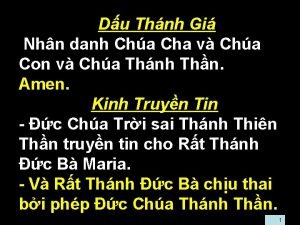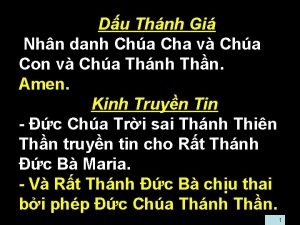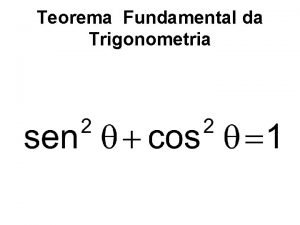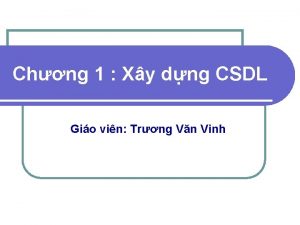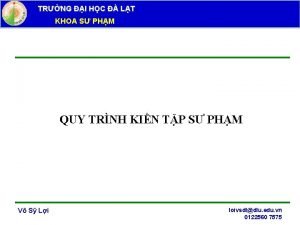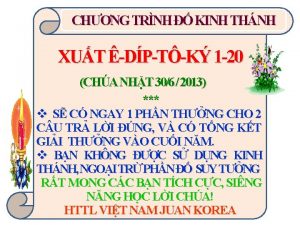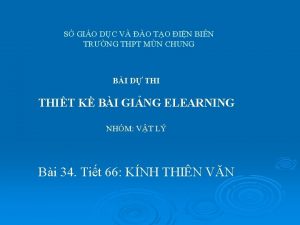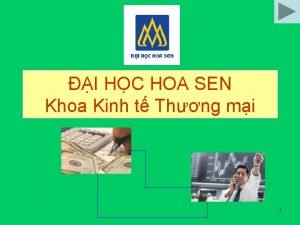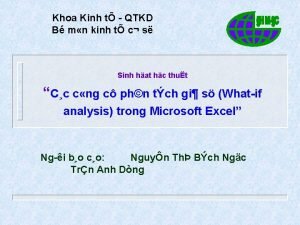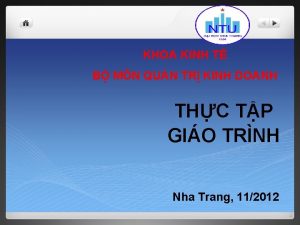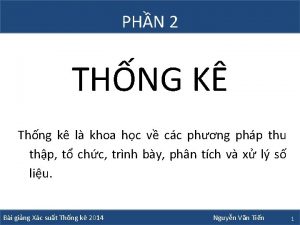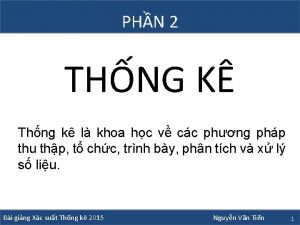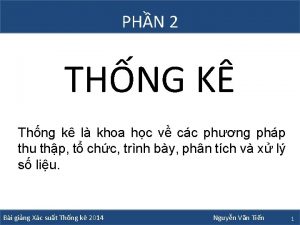I HC HOA SEN Khoa Kinh t Thng




































- Slides: 36

ĐẠI HỌC HOA SEN Khoa Kinh tế Thương mại 1

KHOA KINH TẾ THƯƠNG MẠI FINANCIAL MANAGEMENT Th. S. Nguyễn Tường Minh Email: minh. nguyentuong@yahoo. com. vn 2

References • Foundation of Financial Management, Block & Hirt, Mc. Graw Hill, 13 th edition, USA, 2009. • Fundamentals of Corporate Finance, Brealey et al. , Mc. Graw Hill, 5 th edition, USA, 2007. • Other relevant materials. 3

Chapter 17: Common and Preferred Stock Financing v Chapter Concepts – Common stockholders are the owners of the corporation and therefore have a claim to undistributed income, the right to elect the board of directors and other privileges – Cumulative voting provides minority stockholders with the potential for some representation on the board of directors – A rights offering gives current stockholders a first option to purchase new shares – Poison pills and other similar provisions may make it difficult for outsiders to take over a corporation against management’s wishes – Preferred stock is an intermediate type of security that falls somewhere between debt and common stock 4

Chapter 17: Common and Preferred Stock Financing • Main Contents: 1. 2. 3. 4. 5. 6. 7. Common Stockholders’ Claim to Income The Voting Right The Right to Purchase New Shares American Depository Receipts Preferred Stock Financing Provisions Associated with Preferred Stock Comparing Features of Common ad Preferred Stock and Debt 5

I. Common Stockholders’ Claim to Income – All income belongs to common stockholders if it is not paid to creditors or preferred stockholders – The income will be paid out as common stock dividends and reinvested as a retained earning with the hope of providing even greater income, dividends, and price appreciation in the future – The common stockholders do not have a legal or enforceable claim to dividends 6

II. The Voting Right – The stockholders are accorded the right to vote in the election of the board of directors and on all other major issues – The “founders’ stock” – marked as class B share for the founders, and preserve partial control of the company while at the same time raise new capital for expansion – Both common and Class B stockowners share in dividends equally – Class B is convertible into regular common stock on a share-for-share basis – Bondholders and preferred stockholders may vote only when a violation of their corporate agreement exists 7

II. The Voting Right (cont’d) v Cumulative Voting – Majority voting – any group of stockholders owning over 50% of the common stock may elect all the directors – Cumulative voting – it is possible for those who hold less than a 50% interest to elect some of the directors 8

II. The Voting Right (cont’d) v Cumulative Voting (cont’d) – To determine the number of votes – Assume there are 10, 000 shares outstanding, you own 1, 001 shares, 9 directors are to be elected. How many vote would you have to elect one director ? – What is the total vote for the election of the board of directors ? 9

II. The Voting Right (cont’d) v Cumulative Voting (cont’d) – To determine the number of shares needed to elect a given number of directors under cumulative voting: – Assume there are 10, 000 shares outstanding, 9 directors are to be elected. How many shares would elect one director ? – How many shares would elect three directors ? 10

II. The Voting Right (cont’d) v Cumulative Voting (cont’d) – To determine the number of directors that can be elected: – Assume you own 3, 001 shares, and 9 directors are to be elected, and there are 10, 000 outstanding shares. How many director can you elect ? 11

III. The Right to Purchase New Shares – In a rights offering, each shareholder is issued rights to buy a specified number of new shares at a specified price within a specified time – Rights such as share warrant are traded on securities exchanges or OTC – Rights are cheaper for the issuing firm than cash offers (a firm can do a right without underwriters) 12

III. The Right to Purchase New Shares (cont’d) 1. The mechanics of a rights offering – As receiving the rights offer, the existing shareholders have three choices: i. Exercise their rights and subscribe for some or all of the entitled shares ii. Order some or all of the rights sold iii. Do nothing and let the rights expire 13

III. The Right to Purchase New Shares (cont’d) 1. The mechanics of a rights offering (cont’d): – To fund a planned expansion, the company intends to raise $5 million worth of new equity funds through a rights offering 14

III. The Right to Purchase New Shares (cont’d) 1. The mechanics of a rights offering (cont’d): – The key questions in executing a rights offering: i. What should the price per share be for the new stock ? ii. How many shares will have to be sold ? iii. How many shares will each shareholder be allowed to buy ? iv. What is likely to be the effect of the rights offering on the per-share value of the v. existing stock ? 15

III. The Right to Purchase New Shares (cont’d) 2. Number of rights needed to purchase a share Assuming that the subscription price is $10 per share = $5, 000 / 10 = 500, 000 shares – Subscription price – a static price at which existing shareholders can participate in a rights offering, so they may retain their proportional ownership of the business 16

III. The Right to Purchase New Shares (cont’d) 2. Number of rights needed to purchase a share = 1, 000 / 500, 000 = 2 rights A shareholder will need to give up 2 rights plus $10 for each new share 17

III. The Right to Purchase New Shares (cont’d) 3. Value of the right – Suppose that a shareholder owns two shares of stock before the rights offering is about to expire 18

III. The Right to Purchase New Shares (cont’d) 3. Value of the right (cont’d) – What happen to the company’s stock price ? 19

III. The Right to Purchase New Shares (cont’d) 4. Ex rights – The rights offering have a large impact on the market price of the firm’s stock The price drop (by $3. 33) on the ex-right date – Ex-right date – the beginning of the period when stock is sold without a recently declared right, two trading days before the holder-of-record date – The holder-of-record date – the date on which existing shareholders are designated as the recipients of stock rights 20

III. The Right to Purchase New Shares (cont’d) 4. Ex rights (cont’d) – To raise $5 million, shares are needed to be sold are 625, 000 (5, 000 / 8) – There are 1 million shares outstanding, it will take 1. 6 rights to buy a new share (1 million / 625, 000) – After the rights offer, there will be 1. 625 million shares, worth $25 million, so value per share will be $15. 38 ($25/1. 625) – The value of the right is $4. 62 (20$ - $15. 38) 21

III. The Right to Purchase New Shares (cont’d) 4. Ex rights (cont’d) – Five rights on share can be bought for $200 (5 x $40) – To possess one new share, the shareholder will need to give up 5 rights plus $25 – Your total investment is $225, and you end up with 6 (ex-rights) shares – The ex-right price per share is $37. 50 ($225 / 6) – The rights are worth $2. 50 a piece ($40 – 37. 50) 22

III. The Right to Purchase New Shares (cont’d) 4. Ex rights (cont’d) – Buy 5 rights for $10 – Exercise 5 rights and pay $25 to get a new share – Your total investment to get one ex-rights share is $35 – Sell the share for $37. 50 and pocket the $2. 5 difference (5 x $2 + 25) 23

III. The Right to Purchase New Shares (cont’d) 5. Effect on shareholders – If the shareholder sells the two right for $3. 33 each, and end up with two shares worth $16. 67, and the cash selling from the right: • Share held = $33. 33 (2 x $16. 67) • Right sold = $6. 67 (2 x $3. 33) • Total = $40. 00 – The new $33. 33 market value plus $6. 67 in cash is exactly the same as the original holding of $40. Stockholders cannot lose or gain by exercising or selling rights 24

III. The Right to Purchase New Shares (cont’d) 6. Poison Pills Hidden acquisitor…accumulates 25% of the share The boss • Decide to issue the right to purchase the additional shares with the very low price to the other shareholders • This makes the ownership percentage of the acquisitor dilute Trigger point 25

IV. American Depository Receipt Offering the security for sale in the U. S Issuing ADRs in American 26

IV. American Depository Receipt (cont’d) – American Depository Receipts (ARDs) – certificates that have a legal claim on an ownership interest in common stock of a foreign company issue Purchased and put in trust CITIBANK Helsinki branch ARD NOKIA’s stock 27 American investor

IV. American Depository Receipt (cont’d) v Characteristics of ARD – ADRs are traded in dollars – Dividends are paid in dollar – Dividends are more easily collected than if the actual shares of the foreign stocks were owned – ARDs are considered to be more liquid, less expensive, and easier to trade than buying foreign companies’ stock directly on that firm’s home exchange – The ARDs’ investors are subject to the foreign currency risk 28

V. Preferred Stock Financing – Preferred stock – an intermediate and hybrid form of security of bonds and common stocks – Preferred stockholders are entitled to receive a stipulated dividend before the payment of dividends to common stockholders – The right of the preferred stockholder to annual dividends is not mandatory for the corporation 29

V. Preferred Stock Financing (cont’d) v Justification for Preferred Stock Why might the corporation issue the preferred stock ? – A means to expand the capital base of the firm without diluting the common stock ownership position or incurring debt obligations 30

V. Preferred Stock Financing (cont’d) v Justification for Preferred Stock (cont’d) Why are the investors willing to purchase the preferred stock ? – Primary purchasers of preferred stock (corporate investors) have a very attractive advantage over bonds: • Only 30% of the dividend would be taxable, while all interest of bond is taxable except the municipal bond 31

V. Preferred Stock Financing (cont’d) v Justification for Preferred Stock (cont’d) Summary of Tax Considerations – For issuing corporation, the after-tax cost of debt is cheaper than preferred stock – For corporate investor, the receipt of preferred dividends is more valuable than corporate bond interest 32

VI. Provisions Associated with Preferred Stock 1. 2. 3. 4. 5. 6. 7. Cumulative Dividends Conversion Feature Call Feature Participation Provision Floating Rate Dutch Auction Preferred Stock Par Value 33

VII. Comparing Feature of Common and Preferred Stock and Debt 34

VII. Comparing Feature of Common and Preferred Stock and Debt (cont’d) 35

Thank you for your attention ! 36
 Kinh tin kính
Kinh tin kính Kinh vực sâu kinh bởi trời
Kinh vực sâu kinh bởi trời Kinh tin kính
Kinh tin kính Kinh tin kinh
Kinh tin kinh Kinh lạy cha
Kinh lạy cha Thng
Thng Nhược điểm của túi tiêu hóa
Nhược điểm của túi tiêu hóa Hoa mướp có nhị hay nhụy
Hoa mướp có nhị hay nhụy Những cây nào sau đây thuộc cây ngắn ngày
Những cây nào sau đây thuộc cây ngắn ngày Bayram özünü bildi bileni anda buldu
Bayram özünü bildi bileni anda buldu Sen 90
Sen 90 Periodo di sin^2
Periodo di sin^2 Sen (a-b)
Sen (a-b) Tạo thuộc tính lookup cho các trường khóa ngoại
Tạo thuộc tính lookup cho các trường khóa ngoại Bìa tiểu luận trường đại học đà lạt
Bìa tiểu luận trường đại học đà lạt Tạo thuộc tính lookup cho các trường khóa ngoại
Tạo thuộc tính lookup cho các trường khóa ngoại Hộp khóa nòng
Hộp khóa nòng Chu nghia xa hoi khoa hoc
Chu nghia xa hoi khoa hoc Bản đồ kinh thánh
Bản đồ kinh thánh Chiến lược kinh doanh quốc tế của walmart
Chiến lược kinh doanh quốc tế của walmart Cách nhận biết thấu kính hội tụ và tkpk
Cách nhận biết thấu kính hội tụ và tkpk Slide đạo đức kinh doanh
Slide đạo đức kinh doanh 1 tit
1 tit Tôi tin kính một thiên chúa là cha toàn năng
Tôi tin kính một thiên chúa là cha toàn năng Tìm miền hội tụ của chuỗi hàm
Tìm miền hội tụ của chuỗi hàm Tứ giác velpeau
Tứ giác velpeau đố kinh thánh sách các quan xét
đố kinh thánh sách các quan xét 5 hình thái kinh tế xã hội
5 hình thái kinh tế xã hội Thần kinh đùi
Thần kinh đùi Này giờ đây đoàn con tiến dâng lên ngài
Này giờ đây đoàn con tiến dâng lên ngài Kinh lạy cha
Kinh lạy cha Ra về trong hy vọng và mừng vui
Ra về trong hy vọng và mừng vui Kinh h
Kinh h đố kinh thánh xuất ê-díp-tô ký
đố kinh thánh xuất ê-díp-tô ký Kính tiềm vọng
Kính tiềm vọng đây là nước nào
đây là nước nào Một học sinh cận thị có các điểm cc cv
Một học sinh cận thị có các điểm cc cv

